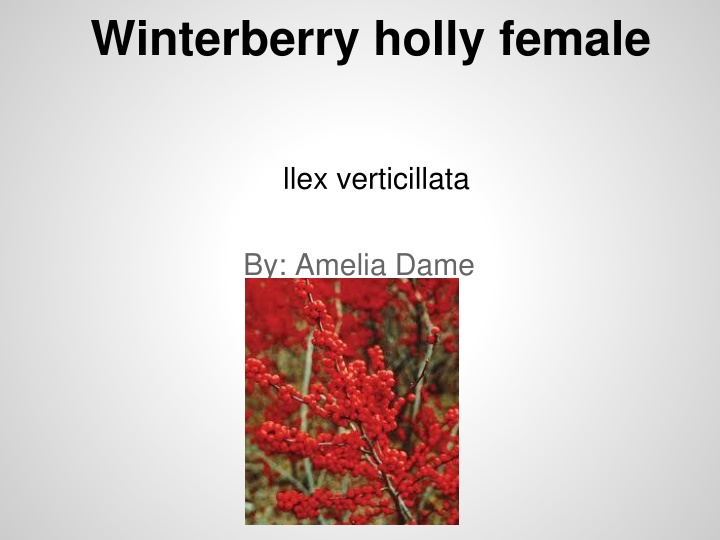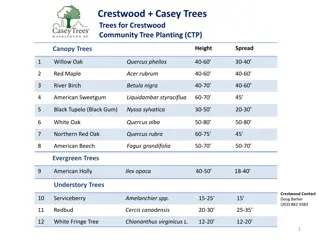Winterberry Holly: Care Guide and Planting Tips
Winterberry holly, known as Ilex verticillata, is a beautiful shrub with red berries that provide food for wildlife during winter. This guide covers its soil needs, diseases, fall appearance, mature height, wildlife benefits, reproduction methods, and planting recommendations near water bodies. Check the bibliography for further information.
Download Presentation

Please find below an Image/Link to download the presentation.
The content on the website is provided AS IS for your information and personal use only. It may not be sold, licensed, or shared on other websites without obtaining consent from the author.If you encounter any issues during the download, it is possible that the publisher has removed the file from their server.
You are allowed to download the files provided on this website for personal or commercial use, subject to the condition that they are used lawfully. All files are the property of their respective owners.
The content on the website is provided AS IS for your information and personal use only. It may not be sold, licensed, or shared on other websites without obtaining consent from the author.
E N D
Presentation Transcript
Winterberry holly female llex verticillata By: Amelia Dame
Soil The winterberry needs moist soil. I doesn't do very well in dry conditions. Diseases and pests Anthracnose is a fungal disease that appears as tan spots on the leafs. a fungicide should be sprayed on it. Pythium and Phytophthora Root Rot is another disease that attacks the root of the plant. It is caused by overly moist soil.
Fall color the winter berry has green leaves during the fall but they slowly fall off by winter. During winter the red berries stay but the stems turn blackish brown. Sun The winterberry holly can grow in partial or full sun. This plant makes for a good decoration during the winter because the berries stay bright red.
Mature height The mature height for a winterberry holly is 15 feet but it can verify. Winterberries in the wild can grow up to 16 feet sometimes. Wildlife use The berries of the winterberry holly are a good food source for birds, squirrels and even raccoons. These berries are really a food source for any small mammal.
How does the shrub reproduce? A winterberry holly comes in both male and female. So to get the plants to reproduce, you plant the two plants within 40 feet of each other. That will allow them to pollinate. If you are worried about the winterberries getting killed by (for example) deer, then you should plant more females than males to make sure the female will reproduce.
I recommend planting the winterberry holly. The best place to plant it is by a pond or lake. You will need to plant many female winter berries And fewer male so that the male can fertilize the females.
Bibliography http://www.gardenguides.com/87817-diseases-winterberry-holly-plants.html http://utgardens.tennessee.edu/pom/winterberry_holly.htm http://plants.usda.gov/factsheet/pdf/fs_ilve.pdf http://gardening.about.com/od/floweringshrubs/a/WinterberryHoll.htm






















